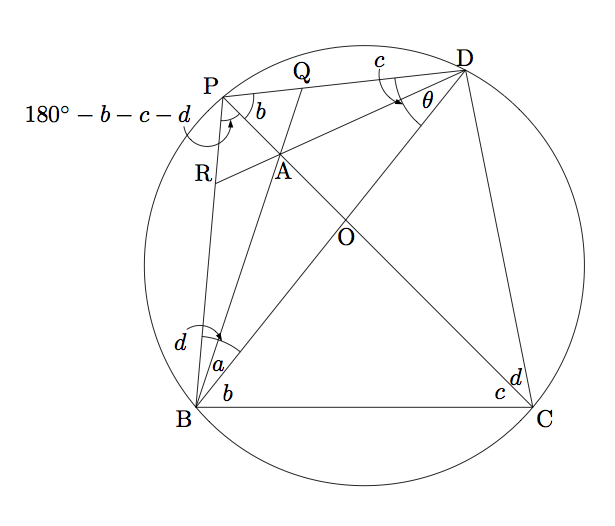CodeIQにて、Kawazoeさん(@riverplus)の問題「コード・トライアスロン2」を解きました。解答は記事の最下部に示します。本記事では、特に第一問の解き方を書いておきます。
■問題概要
- 四角形ABCDについて、∠ABD=a,∠CBD=b,∠ACB=c,∠ACD=dとおいたとき、∠ADBを106倍したものの整数部分F(a,b,c,d)を求める。
- 自然数nに対し、次の性質をもつ自然数dの総和をG(n)と定義する。
「nをdで割った余りが1に等しい」
1の結果を受け取り、G(F(a,b,c,d))を求める。 - 先頭にゼロを持たない自然数であって、逆から読んでも同じ数になる数を回文数という(例:1,22,343,440044,7890987)。自然数mに対し、m以下の回文数の総和をH(m)と定義する。2の結果を受け取り、H(G(F(a,b,c,d)))を求める。
■第一問の解き方
四角形ABCDの対角線の交点をOとする。
四角形ABCDの点B,C,Dを通る円を描き、
四角形ABCDの対角線ACの延長との交点をPとする。
また、PDとABの延長との交点をQ、PBとADの延長との交点をRとする。
∠ABD=a, ∠CBD=b,∠ACB=c,∠ACD=dより、
弧CDの円周角なので∠CPD=∠CBD=b、
弧BPの円周角なので∠BDP=∠BCP=∠ACB=c、
弧DPの円周角なので∠DBP=∠DCP=∠ACD=dとなる。
また、三角形PBCの内角の和を180°なので、
∠BPC=180°−b−c−dとなる。
三角形PBDにおいてチェバの定理より
\begin{eqnarray}
&&\frac{\hbox{BO}}{\hbox{OD}}\cdot\frac{\hbox{DQ}}{\hbox{QP}}\cdot\frac{\hbox{PR}}{\hbox{RB}}=1\\
&\Leftrightarrow&\frac{\bigtriangleup\hbox{PBO}}{\bigtriangleup\hbox{POD}}\cdot
\frac{\bigtriangleup\hbox{BDQ}}{\bigtriangleup\hbox{BQP}}\cdot
\frac{\bigtriangleup\hbox{DPR}}{\bigtriangleup\hbox{DRB}}=1\\
&\Leftrightarrow&\frac{\frac{1}{2}\cdot\hbox{PB}\cdot\hbox{PO}\cdot\sin\angle\hbox{OPB}}
{\frac{1}{2}\cdot\hbox{PD}\cdot\hbox{PO}\cdot\sin\angle\hbox{OPD}}\cdot
\frac{\frac{1}{2}\cdot\hbox{BD}\cdot\hbox{BQ}\cdot\sin\angle\hbox{QBD}}
{\frac{1}{2}\cdot\hbox{BP}\cdot\hbox{BQ}\cdot\sin\angle\hbox{QBP}}\cdot
\frac{\frac{1}{2}\cdot\hbox{DP}\cdot\hbox{DR}\cdot\sin\angle\hbox{RDP}}
{\frac{1}{2}\cdot\hbox{DB}\cdot\hbox{DR}\cdot\sin\angle\hbox{RDB}}=1\\
&\Leftrightarrow&\frac{\sin\angle\hbox{OPB}}{\sin\angle\hbox{OPD}}\cdot
\frac{\sin\angle\hbox{QBD}}{\sin\angle\hbox{QBP}}\cdot
\frac{\sin\angle\hbox{RDP}}{\sin\angle\hbox{RDB}}=1\\
&\Leftrightarrow&\frac{\sin(180^\circ-b-c-d)}{\sin b}\cdot
\frac{\sin a}{\sin(d-a)}\cdot
\frac{\sin(c-\theta)}{\sin\theta}=1\\
&\Leftrightarrow&\frac{\sin(b+c+d)}{\sin b}\cdot
\frac{\sin a}{\sin(d-a)}\cdot
\frac{\sin c \cos \theta – \cos c \sin \theta}{\sin\theta}=1\\
&\Leftrightarrow&\frac{\sin c \cos \theta – \cos c \sin \theta}{\sin\theta}=
\frac{\sin b \sin(d-a)}{\sin(b+c+d)\sin a}\\
&\Leftrightarrow&\frac{\sin c}{\tan\theta}-\cos c=\frac{\sin b \sin (d-a)}{\sin(b+c+d)\sin a}\\
&\Leftrightarrow&\sin c-\cos c \tan\theta=\frac{\sin b \sin(d-a)}{\sin(b+c+d)\sin a}\cdot\tan\theta\\
&\Leftrightarrow&\left(\frac{\sin b \sin(d-a)}{\sin(b+c+d)\sin a}+\cos c \right)\cdot\tan\theta=\sin c\\
&\Leftrightarrow&\tan\theta=\frac{\sin c}{\frac{\sin b \sin(d-a)}{\sin(b+c+d)\sin a}+\cos c}\\
&\Leftrightarrow&\tan \theta=\frac{\sin(b+c+d)\sin a \sin c}{\sin b \sin(d-a)+\sin(b+c+d)\sin a \cos c}
\end{eqnarray}
\)
θの106を求めるようC++で書くと以下のようになります。
double f = atan((sin((b + c + d) * M_PI / 180) * sin(a * M_PI / 180) *
sin(c * M_PI / 180)) /
(sin(b * M_PI / 180) * sin((d - a) * M_PI / 180) +
sin((b + c + d) * M_PI / 180) * sin(a * M_PI / 180) *
cos(c * M_PI / 180))) * 180000000 / M_PI;
if(f < 0) {
f += 180000000;
}
■解答
あまり綺麗なコードではないですが、C++で書いた解答を以下に示します。
#include <iostream>
#include <iterator>
#include <string>
#include <vector>
#include <sstream>
#include <math.h>
#include <stdlib.h>
#define _USE_MATH_DEFINES
using namespace std;
vector<string> split(const string &str){
istringstream iss(str);
vector<string> res;
copy(istream_iterator<string>(iss), istream_iterator<string>(),
back_inserter(res));
return res;
}
struct hResult {
public:
vector<string> cache;
long long result;
hResult() {
result = 0;
}
};
hResult h(int size, int limit) {
int limitSize = to_string(limit).size();
if(size == 1) {
hResult result;
int j = 0;
for(int i = (size == limitSize) ? 1 : 0; i <= 9; i++) {
if(i <= limit) {
result.result += i;
result.cache.push_back(to_string(i));
} else {
break;
}
}
return result;
} else if(size == 2) {
hResult currentResult, result;
int j = 0;
if(limitSize == 2) {
result = h(1, limit);
}
for(int i = (size == limitSize) ? 1 : 0; i <= 9; i++) {
string numStr = to_string(i) + to_string(i);
int numInt = stoi(numStr);
if(numInt <= limit) {
currentResult.result += numInt;
currentResult.cache.push_back(numStr);
} else {
break;
}
}
if(limitSize == 2) {
currentResult.result += result.result;
}
return currentResult;
} else {
hResult result = h(size - 2, limit);
hResult currentResult;
int cacheSize = result.cache.size();
currentResult.result += result.result;
if(size == limitSize) {
currentResult.result += h(size - 1, limit).result;
}
for(int i = (size == limitSize) ? 1 : 0; i <= 9; i++) {
for(int j = 0; j < cacheSize; j++) {
string numStr = to_string(i) + result.cache[j] + to_string(i);
int numInt = 0;
if(i != 0) {
numInt = stoi(numStr);
}
if(numInt <= limit) {
currentResult.result += numInt;
currentResult.cache.push_back(numStr);
} else {
i = 10;
break;
}
}
}
return currentResult;
}
}
int main() {
string line;
int a, b, c, d = 0;
for(; getline(cin, line); ) {
vector<string> tmp = split(line);
a = stoi(tmp[0]);
b = stoi(tmp[1]);
c = stoi(tmp[2]);
d = stoi(tmp[3]);
}
double f = atan((sin((b + c + d) * M_PI / 180) * sin(a * M_PI / 180) *
sin(c * M_PI / 180)) /
(sin(b * M_PI / 180) * sin((d - a) * M_PI / 180) +
sin((b + c + d) * M_PI / 180) * sin(a * M_PI / 180) *
cos(c * M_PI / 180))) * 180000000 / M_PI;
if(f < 0) {
f += 180000000;
}
int F = stoi(to_string(f));
int G = 0;
for(int i = 1; i < F; i++) {
if(F % i == 1) {
G += i;
}
}
hResult H = h(to_string(G).size(), G);
cout<<H.result<<endl;
}
参考:
ラングレーの問題、整角四角形
チェバの定理・メネラウスの定理
PickUp問題②:ラングレーの問題における三角関数の扱い方
C++で文字列のsplit | Story of Your Life
